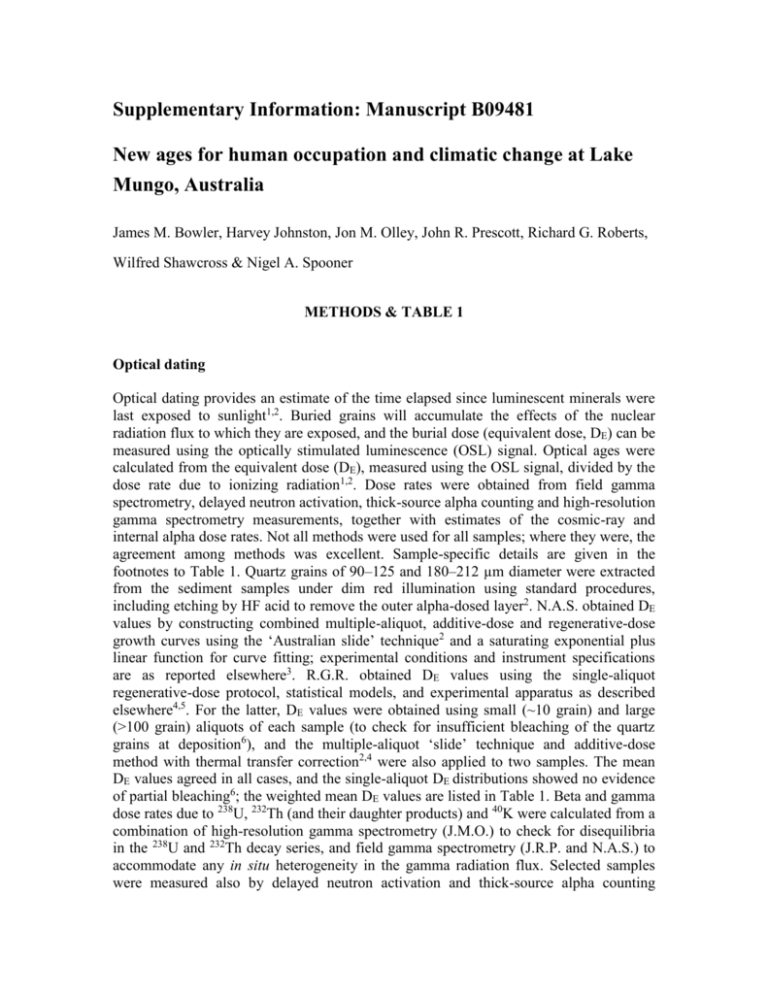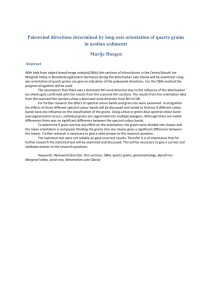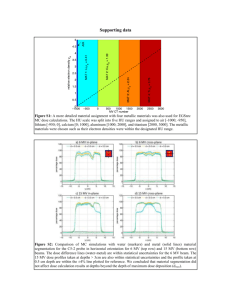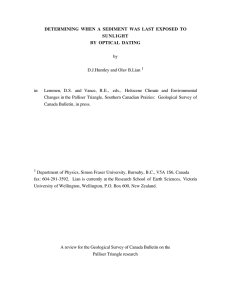Word file (28 KB )
advertisement

Supplementary Information: Manuscript B09481 New ages for human occupation and climatic change at Lake Mungo, Australia James M. Bowler, Harvey Johnston, Jon M. Olley, John R. Prescott, Richard G. Roberts, Wilfred Shawcross & Nigel A. Spooner METHODS & TABLE 1 Optical dating Optical dating provides an estimate of the time elapsed since luminescent minerals were last exposed to sunlight1,2. Buried grains will accumulate the effects of the nuclear radiation flux to which they are exposed, and the burial dose (equivalent dose, DE) can be measured using the optically stimulated luminescence (OSL) signal. Optical ages were calculated from the equivalent dose (DE), measured using the OSL signal, divided by the dose rate due to ionizing radiation1,2. Dose rates were obtained from field gamma spectrometry, delayed neutron activation, thick-source alpha counting and high-resolution gamma spectrometry measurements, together with estimates of the cosmic-ray and internal alpha dose rates. Not all methods were used for all samples; where they were, the agreement among methods was excellent. Sample-specific details are given in the footnotes to Table 1. Quartz grains of 90–125 and 180–212 µm diameter were extracted from the sediment samples under dim red illumination using standard procedures, including etching by HF acid to remove the outer alpha-dosed layer2. N.A.S. obtained DE values by constructing combined multiple-aliquot, additive-dose and regenerative-dose growth curves using the ‘Australian slide’ technique2 and a saturating exponential plus linear function for curve fitting; experimental conditions and instrument specifications are as reported elsewhere3. R.G.R. obtained DE values using the single-aliquot regenerative-dose protocol, statistical models, and experimental apparatus as described elsewhere4,5. For the latter, DE values were obtained using small (~10 grain) and large (>100 grain) aliquots of each sample (to check for insufficient bleaching of the quartz grains at deposition6), and the multiple-aliquot ‘slide’ technique and additive-dose method with thermal transfer correction2,4 were also applied to two samples. The mean DE values agreed in all cases, and the single-aliquot DE distributions showed no evidence of partial bleaching6; the weighted mean DE values are listed in Table 1. Beta and gamma dose rates due to 238U, 232Th (and their daughter products) and 40K were calculated from a combination of high-resolution gamma spectrometry (J.M.O.) to check for disequilibria in the 238U and 232Th decay series, and field gamma spectrometry (J.R.P. and N.A.S.) to accommodate any in situ heterogeneity in the gamma radiation flux. Selected samples were measured also by delayed neutron activation and thick-source alpha counting (J.R.P.). A condition of secular equilibrium presently exists in the 238U and 232Th decay chains for all samples, except those from the Mungo I Residual, which have 238U deficits of 42–56% relative to 226Ra. Such deficits, however, have an insignificant effect on the optical ages when, as here, the 238U chain accounts for a minor fraction (<20%) of the total dose rate. The internal alpha dose rate for all samples was estimated from instrumental neutron activation and inductively-coupled plasma mass spectrometry measurements of U and Th concentrations in acid-etched quartz grains from 11 samples (N.A.S.). Alpha-efficiency, beta-dose attenuation, and dose-rate conversion factors were extracted from publications7–9 and the beta, gamma and cosmic-ray dose rates were corrected2 for the estimated long-term water content of each sample. The cosmic-ray dose rates were calculated from published data10, making allowance for site altitude, geomagnetic latitude and time-averaged thickness of sediment overburden. The timeaveraged burial depth and long-term water content of each sample were estimated by J.M.B. from reconstructions of the lunette profile and lake hydrology over the last 60 kyr, with associated uncertainties sufficient to accommodate all likely possibilities. As an inter-laboratory test of reproducibility, four duplicate samples were processed independently by N.A.S. and R.G.R. using different protocols to determine the DE values, laboratory beta-sources calibrated using different standards, and dose rates calculated using largely independent data sets. The optical ages are in agreement, giving added confidence to the OSL chronology for Lake Mungo. Dust index Desert dust contains a high percentage of 20–60 µm diameter quartz grains coated with distinctive red clay skins (argillic cutans). Dust grains transported in suspension from red desert soils are identical to the red silt-sized quartz identified as Sarahan-derived dust (Wüstenquarz) in Atlantic marine sediments11. The red coatings and their silt size distinguish dust grains from locally-derived lake and lake-shore sediments, which are well sorted with modal peaks near 0.4 mm. Dust grains are almost always associated with a reddish-brown clay matrix, the companion component of Australian desert dust. A ‘dust index’ was established by counting silt-sized argillic quartz grains (over an area of 1 cm2 on a micrometer stage) in petrographic thin-sections of undisturbed sediment samples. The resulting index is expressed as grains/cm2, a relative measure of the dust component. Table 1 (to insert here) References 1. 2. 3. 4. Huntley, D.J., Godfrey-Smith, D.I. & Thewalt, M.L.W. Optical dating of sediments. Nature 313, 105-107 (1985). Aitken, M.J. An Introduction to Optical Dating (Oxford University Press, Oxford, 1998). Spooner, N.A., Olley, J.M., Questiaux, D.G. & Chen, X.Y. Optical dating of an aeolian deposit on the Murrumbidgee floodplain. Quat. Sci. Rev. 20, 835-840 (2001). Galbraith, R.F., Roberts, R.G., Laslett, G.M., Yoshida, H. & Olley, J.M. Optical dating of single and multiple grains of quartz from Jinmium rock shelter, northern Australia: Part I, experimental design and statistical models. Archaeometry 41, 339364 (1999). 5. Yoshida, H., Roberts, R.G., Olley, J.M., Laslett, G.M. & Galbraith, R.F. Extending the age range of optical dating using single ‘supergrains’ of quartz. Radiat. Meas. 32, 439-446 (2000). 6. Olley, J.M., Caitcheon, G.G. & Roberts, R.G. The origin of dose distributions in fluvial sediments, and the prospect of dating single grains from fluvial deposits using optically stimulated luminescence. Radiat. Meas. 30, 207-217 (1999). 7. Thorne, A. et al. Australia’s oldest human remains: age of the Lake Mungo 3 skeleton. J. Hum. Evol. 36, 591-692 (1999). 8. Mejdahl, V. Thermoluminescence dating: beta-dose attenuation in quartz grains. Archaeometry 21, 61-72 (1979). 9. Adamiec, G. & Aitken, M. Dose-rate conversion factors: update. Ancient TL 16, 3750 (1998). 10. Prescott, J.R. & Hutton, J.T. Cosmic ray contributions to dose rates for luminescence and ESR dating: large depths and long-term time variations. Radiat. Meas. 23, 497500 (1994). 11. Radczewski, O.E. in Recent Marine Sediments: A Symposium (ed P.D. Trask) 496502 (Special Publication 4, Society for Economic Paleontologists & Mineralogists, Tulsa, Oklahoma, 1960). 12. Shawcross, W. Archaeological excavations at Mungo. Archaeol. Oceania 33, 183200 (1998).









